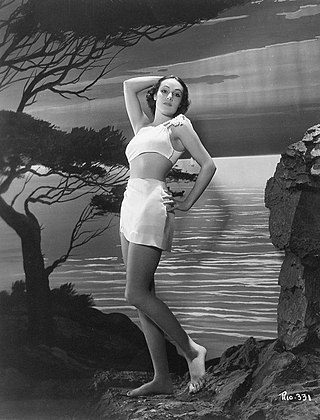
A bikini is a two-piece swimsuit primarily worn by girls and women that features one piece on top that covers the breasts, and a second piece on the bottom: the front covering the pelvis but usually exposing the navel, and the back generally covering the intergluteal cleft and a little, some, or all of the buttocks. The size of the top and bottom can vary, from bikinis that offer full coverage of the breasts, pelvis, and buttocks, to more revealing designs with a thong or G-string bottom that covers only the mons pubis, but exposes the buttocks, and a top that covers only the areolae. Bikini bottoms covering about half the buttocks may be described as "Brazilian-cut".
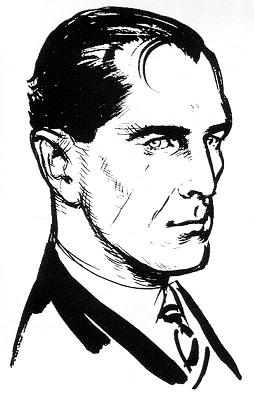
The James Bond series focuses on the titular character, a fictional British Secret Service agent created in 1953 by writer Ian Fleming, who featured him in twelve novels and two short-story collections. Since Fleming's death in 1964, eight other authors have written authorised Bond novels or novelisations: Kingsley Amis, Christopher Wood, John Gardner, Raymond Benson, Sebastian Faulks, Jeffery Deaver, William Boyd, and Anthony Horowitz. The latest novel is With a Mind to Kill by Anthony Horowitz, published in May 2022. Additionally Charlie Higson wrote a series on a young James Bond, and Kate Westbrook wrote three novels based on the diaries of a recurring series character, Moneypenny.

Die Another Day is a 2002 spy film and the twentieth film in the James Bond series produced by Eon Productions. It was directed by Lee Tamahori, produced by Michael G. Wilson and Barbara Broccoli, and written by Neal Purvis and Robert Wade. The fourth and final film starring Pierce Brosnan as the fictional MI6 agent James Bond, it was also the only film to feature John Cleese as Q, and the last with Samantha Bond as Miss Moneypenny. It is also the first film since Live and Let Die (1973) not to feature Desmond Llewelyn as Q as he died three years earlier. Halle Berry co-stars as NSA agent Giacinta "Jinx" Johnson, the Bond girl. It follows Bond as he attempts to locate a traitor in British intelligence who betrayed him and a British billionaire who is later revealed to be connected to a North Korean operative whom Bond seemingly killed. It is an original story, although it takes influence from Bond creator Ian Fleming's novels Moonraker (1955) and The Man with the Golden Gun (1965), as well as Kingsley Amis's novel, Colonel Sun.

A Bond girl is a character who is a love interest, female companion or (occasionally) an adversary of James Bond in a novel, film, or video game. Bond girls occasionally have names that are double entendres or sexual puns, such as Plenty O'Toole, Holly Goodhead, or Xenia Onatopp. The female leads in the films, such as Ursula Andress, Honor Blackman, or Eva Green, can also be referred to as "Bond girls". The term Bond girl may also be considered as an anachronism, with some female cast members in the films preferring the designation Bond woman.
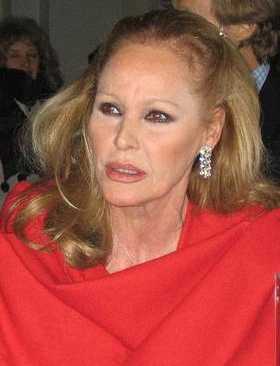
Ursula Andress is a Swiss actress, former model and sex symbol who has appeared in American, British and Italian films. Her breakthrough role was as Bond girl Honey Ryder in the first James Bond film, Dr. No (1962). She later starred as Vesper Lynd in the 1967 Bond parody Casino Royale. Other credits include Fun in Acapulco (1963), 4 for Texas (1963), She (1965), The 10th Victim (1965), The Blue Max (1966), The Southern Star (1969), Perfect Friday (1970), Red Sun (1971), The Sensuous Nurse (1975), Slave of the Cannibal God (1978), The Fifth Musketeer (1979), Clash of the Titans (1981), and Peter the Great (1986).

Casino Royale is a 2006 spy film, the twenty-first in the Eon Productions James Bond series, and the third screen adaptation of Ian Fleming's 1953 novel of the same name. Directed by Martin Campbell from a screenplay by Neil Purvis, Robert Wade, and Paul Haggis, it stars Daniel Craig in his first appearance as Bond, alongside Eva Green, Mads Mikkelsen, Judi Dench, and Jeffrey Wright. In the film, Bond is on assignment to bankrupt terrorism financier Le Chiffre (Mikkelsen) in a high-stakes poker game at the Casino Royale in Montenegro.

Honeychile Rider is a fictional character in Ian Fleming's James Bond novel Dr. No. In the 1962 Bond film of the same name, her name was shortened and spelled Honey Ryder. In the film, she is played by Swiss actress Ursula Andress, with her lines dubbed by Nikki van der Zyl due to Andress' heavy accent.

Casino Royale is a 1967 spy parody film originally distributed by Columbia Pictures featuring an ensemble cast. It is loosely based on the 1953 novel of the same name by Ian Fleming, the first novel to feature the character James Bond. The film stars David Niven as the "original" Bond, Sir James Bond 007. Forced out of retirement to investigate the deaths and disappearances of international spies, he soon battles the mysterious Dr. Noah and SMERSH. The film's tagline: "Casino Royale is too much... for one James Bond!" refers to Bond's ruse to mislead SMERSH in which six other agents are pretending to be "James Bond", namely, baccarat master Evelyn Tremble ; millionaire spy Vesper Lynd ; Bond's secretary Miss Moneypenny ; Bond's daughter with Mata Hari, Mata Bond ; and British agents Coop and The Detainer.

Dr. No is a 1962 spy film directed by Terence Young. It is the first film in the James Bond series. Starring Sean Connery, Ursula Andress, Joseph Wiseman and Jack Lord, it was adapted by Richard Maibaum, Johanna Harwood, and Berkely Mather from the 1958 novel of the same name by Ian Fleming. The film was produced by Harry Saltzman and Albert R. Broccoli, a partnership that continued until 1975. It was followed by From Russia with Love in 1963. In the film, James Bond is sent to Jamaica to investigate the disappearance of a fellow British agent. The trail leads him to the underground base of Dr. Julius No, who is plotting to disrupt an early American space launch from Cape Canaveral with a radio beam weapon.
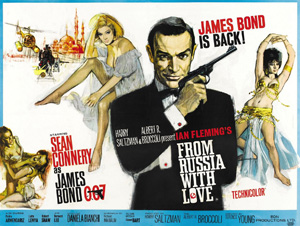
From Russia with Love is a 1963 spy film and the second in the James Bond series produced by Eon Productions, as well as Sean Connery's second role as MI6 agent 007 James Bond.

Vesper Lynd is a fictional character featured in Ian Fleming's 1953 James Bond novel Casino Royale. She was portrayed by Ursula Andress in the 1967 James Bond parody, which is only slightly based on the novel, and by Eva Green in the 2006 film adaptation.

The modern bikini first appeared in 1946, and since then it has become a part of popular culture. It is one of the most widely worn women's swimsuits, used for swimming and in a variety of other contexts. Today, bikinis appear in competitions, films, magazines, music, literature, and video games. Despite the availability of more revealing glamour wear, bikini modeling remains popular and can still create controversy. Portrayals of the bikini in popular culture led, to a large extent, to its acceptance by Western society at large. In 1960, Brian Hyland's pop song "Itsy Bitsy Teenie Weenie Yellow Polkadot Bikini" inspired a bikini-buying spree. The white bikini worn by Ursula Andress as Honey Ryder in the 1962 James Bond film Dr. No has been cited as one of the most famous bikinis of all time. By 1963, the movie Beach Party, starring Annette Funicello and Frankie Avalon, led a wave of films that made the bikini a pop-culture symbol. Playboy first featured a bikini on its cover in 1962. The Sports Illustrated Swimsuit Issue debuted two years later. This increasing popularity was reinforced by its appearance in such contemporary films as How to Stuff a Wild Bikini featuring Annette Funicello and One Million Years B.C. (1966) featuring Raquel Welch. Raquel Welch's fur bikini in One Million Years B.C. became a famous moment in cinema history. Hollywood stars such as Marilyn Monroe, Jayne Mansfield, Gina Lollobrigida and Jane Russell further helped the growing popularity of bikinis. Pin up posters of Monroe and Mansfield, as well as Hayworth, Bardot and Raquel Welch distributed around the world contributed significantly to the popularity of the bikini.

Evidence of bikini-style women's clothing has been found as early as 5600 BC, and the history of the bikini can be traced back to that era. Illustrations of women wearing bikini-like garments during competitive athletic events in the Roman era have been found in several locations, the most famous of which is at Villa Romana del Casale.
Oracabessa is a small town in Saint Mary Parish, Jamaica 10 miles (16 km) east of Ocho Rios. Its population was 4,108 in 2009. Lit in the afternoons by an apricot light that may have inspired its Spanish name, Oracabeza, or "Golden Head", Oracabessa's commercial district consists of a covered produce market and a few shops and bars. The main street is a narrow promenade with a number of well-maintained buildings in the early 20th-century Jamaican vernacular tradition.

Marilyn Monroe wore a white dress in the 1955 film The Seven Year Itch, directed by Billy Wilder. It was created by costume designer William Travilla and worn in the movie's best-known scene. The image of it and her above a windy subway grating has been described as one of the most iconic images of the 20th century.
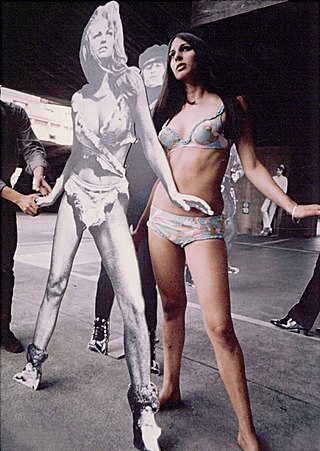
A fur/hide bikini was worn by Raquel Welch in the 1966 British-made prehistoric saga One Million Years B.C. In that bikini, she was described as "wearing mankind's first bikini" and the fur bikini was described as a "definitive look of the 1960s".
The James Bond series of films contain a number of repeating, distinctive motifs which date from the series' inception with Dr. No in 1962. The series consists of twenty five films produced by Eon Productions featuring the James Bond character, a fictional British Secret Service agent. The most recent instalment is No Time to Die, released in UK cinemas on 30 September 2021. There have also been two independently made features, the satirical Casino Royale, released in 1967, and the 1983 film Never Say Never Again.
A bibliography of reference material associated with the James Bond films, novels and genre.

Marie Therese "Tessa" Prendergast, also known as Tessa Welborn, was a Jamaican actress, fashion designer, businesswoman, and socialite. A renowned beauty and movie starlet in the 1950s, she is best-remembered today as the designer of the taboo-breaking white bikini worn by Ursula Andress in the 1962 film Dr. No.

Giacinta "Jinx" Johnson is a fictional character in the James Bond franchise, first appearing in Die Another Day, portrayed by Halle Berry.
















